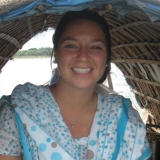EAS at the 2015 AAA meetings in Minneapolis
2015 was a great year for the Evolutionary Anthropology Society. We elected a new PresidentElect—Mary Shenk—as well as two new Board members— Rebecca Sear and Daniel Hruschka—and a new Student Representative—Anne Pisor. Ray Hames transitioned from his role as President into Past President, and Pete Richerson took the helm as our current President. We had a number of excellent publications come out throughout the year that were written by EAS members, and we had a stellar showing at the 114th Annual Meeting of the American Anthropological Association in Denver, Colorado in November. The EAS sponsored seven sessions, including two invited sessions and one round table discussion. (We also hosted a heck of a party, but those stories are better told in person…)
Every year, the EAS awards speakers for outstanding talks given at the meetings. Traditionally, there has been one award for Best Paper by a Student and one award for Best Paper by a New Investigator. This year, there were so many fantastic talks that multiple individuals were rewarded in each category. Each of these talks is highlighted below.
Siobhan Mattison and Adrian Jaeggi both won the New Investigator Award, which is given to scholars who have graduated with their PhD within the last five years.
Mattison’s paper, titled “Kinship and SexBiased Parental Investment Among the Mosuo of Southwest China”, compared birth spacing between patrilineal and matrilineal areas among the Mosuo. She found that families in matrilineal areas who had a son had a shorter time to next birth than those who had a daughter, and that families in patrilineal areas who had a daughter had a shorter time to next birth than those who had a son. Mattison interpreted this as evidence of son preference in patrilineal communities and daughter preference in matrilineal communities. (Click here for more.)
Jaeggi’s paper, titled “Does Market Integration Buffer Risk, Erode Traditional Sharing Practices, and Increase Inequality? A test among Bolivian forager farmers”, examined market integration and cooperation among the Tsimane. He presented two related sets of findings. First, Jaeggi found that Tsimane cooperation across multiple domains is explained by exchange benefits and patterned by supply and demand. In other words, people depend on each other to solve adaptive problems (like producing food or staying healthy). They do this by either reciprocating in kind, or by trading one service for another, resulting in informal divisions of labor. Jaeggi also found that market integration might provide an alternative pathway to achieving food security and could thereby undermine traditional exchange networks. However, he reported that material wealth does not necessarily buffer against common shocks (like flood), and that the materially wealthy invest even more in exchange networks than those with less material wealth. Jaeggi noted that this finding highlights the importance of traditional social capital, which hasn’t yet been replaced by material wealth among the Tsimane foragerfarmers of Bolivia.
Two papers were also awarded Best Paper Given By a Student. Eleanor Power won Best Student Paper (given by a graduate student) and Delaney Glass and Shane Scaggs won Best Student Paper (given by an undergraduate student).
Power’s paper, titled “Subtle and Dramatic: Strategies of Religious Signaling in Rural South India”, examined how gender, age and caste interact to shape the decisions to employ particular religious signals. Power first discussed the rituals that take place in concert with religious life in rural South India. These can entail dramatic, highly costly acts, like when devotees pierce their skin with spears, walk across hot coals, or become possessed by the deity. These costly acts signal religious devotion and commitment and reward their actors with reputational and social capital benefits. However, religious rituals can also entail more subtle acts. Power showed that much of the patterning of the intensity of public ritual performance can be explained by the differential costs and benefits faced by actors in different social positions. She also showed that reputational and relational consequences of talk or gossip differ across caste, gender and age, and that individuals take these potential consequences into account when making decisions about participating in religious ritual. Ultimately, Power argued that these dynamics highlight the role of social position and social capital in structuring people’s strategies for building and maintaining social support. (For more on Power’s work, click here.)
Glass and Scaggs’ paper, titled “Four Pathways to Generosity: Evolutionary mechanisms differentially affect charitable donations”, used two economic games (a public goods game and an allocation game) in which subjects were asked to donate money in order to study individuals’ propensity to donate to charitable organizations. Glass and Scaggs considered four evolutionary mechanisms that have been found to influence prosocial actions: inclusive fitness, reciprocal altruism, indirect reciprocity, and costly signaling. They found that people’s expectations and life experiences determined where they gave, to whom, and how much. They also found that people who donated less often to charity were more likely to donate if a relative solicited them for money, while people who volunteered on a regular basis gave more money when solicited by a member of a nonprofit organization. (For here for more.)
Congratulations to all of the winners and to all who gave talks in EAS sessions. EAS board members have worked hard to increase the number of sessions we have as a society and members have made each of these sessions a success. This year’s meetings will be in Minneapolis in November, so add the dates to your calendar now.
Upcoming dates of importance:
- Deadline to submit a session for the AAAs: March 15th, 2016 (email session proposal to shenkm@missouri.edu).
- Deadline to submit a talk for the AAAs: April 15th, 2016 (see AAA website for instructions).
